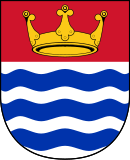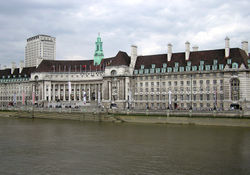Greater London Council
The Greater London Council ( GLC ) was the main administrative body of Greater London between 1965 and its dissolution in 1986 . The GLC was the successor to the Metropolitan Board of Works (MBW, 1855-1889) and the London County Council (LCC, 1888-1965). He was solely responsible for local public transport, the fire service , emergency planning and disaster control . Together with the London Boroughs , he was responsible for road construction, social housing and the construction of leisure facilities. The boroughs themselves were responsible for other tasks.
founding
The Labor Party had dominated London County Council since 1934. In the 1950s, the Conservative Party- led government came to the conclusion that the elections were becoming increasingly one-sided because the LCC was only responsible in the inner city districts (now Inner London ), where the majority of the population voted for Labor. The government was looking for ways to create an administrative authority for all of London, as the outer parts of the city were mostly conservative.
In 1957 a parliamentary commission was set up. In 1960 this recommended the creation of 52 London boroughs as a basis for local self-government. The LCC was also intended to replace the existing but less empowered planning authorities for all of London. The recommendations were largely complied with, but the number of London Boroughs was limited to 32. The Greater London administrative unit, founded on April 1, 1965, comprised the Counties of London and almost all of Middlesex as well as parts of Essex , Hertfordshire , Kent and Surrey , plus the previously independent independent cities of Croydon , East Ham and West Ham .
Political control
The first elections for the GLC took place on April 9, 1964 in all future London boroughs. Contrary to the hopes of the Conservatives, the Labor Party achieved a comfortable absolute majority (64 Labor, 36 Conservatives); Bill Fiske became the first chairman of the GLC. In the next elections in 1967, dissatisfaction with the national government led to a reversal of the situation (82 Conservatives, 18 Labor). Desmond Plummer became the first Conservative chairman of a citywide administrative agency in 34 years. In 1970 the Conservatives also won, albeit with a reduced majority.
In 1972 there was a change in the electoral system. There were only constituencies with one mandate and the GLC's term of office was now four instead of three years. In the 1973 election, Labor won with a heavily socialist manifesto. 57 seats went to Labor, 33 seats to the Conservatives and two seats to the Liberal Party .
The plans of the GLC majority under its chairman, Reg Goodwin , were dampened by the 1974 oil crisis . The high inflation and budget deficit of 1.6 billion pounds resulted in a massive tax hike and unpopular benefit cuts. A few months before the 1977 elections, Labor began to split into two groups. The left-wing group, led by Ken Livingstone , rejected the party's official manifesto.
The Conservatives came back to power in May 1977 after winning 64 seats under the leadership of Horace Cutler ; Labor only got 28 seats. Cutler, a Thatcherist , cut the budget and got rid of costly social housing . The Labor Party remained at odds. Goodwin resigned surprisingly in 1980, in the following internal party election for chairmanship, Livingstone was only barely defeated by the moderate Andrew McIntosh . But Livingstone's camp was able to gain control of the party by the 1981 elections and organize the election program according to their ideas.
Before the May 1981 elections, Conservatives claimed that, immediately after a Labor election victory, Andrew McIntosh would be replaced by Ken Livingstone. McIntosh and party leader Michael Foot asserted this was untrue. In the end, Labor won by a slim majority of six seats. Just a day after the elections, the Labor left prevailed, ousted McIntosh and elected Livingstone as GLC chairman. Livingstone managed to get most of his cause through and soon became a very popular politician.
Abolition and replacement
Keeping Livingstone's socialist election promises proved very costly, which inevitably led to a conflict with Prime Minister Margaret Thatcher's government. Livingstone provoked the government wherever he could. For example, he had a giant neon sign with the current unemployment figures put up on the facade of County Hall , the seat of the GLC, directly opposite the Palace of Westminster , the seat of Parliament.
In 1983 the government decided to dissolve the GLC. She argued that the GLC was inefficient and unnecessary, that the work could be done at least as well by the boroughs. However, it was actually abolished for purely political reasons. The Local Government Act , which provided for the dissolution of the GLC on March 31, 1986, received a slim majority in the House of Commons . During her last tenure, the GLC was mainly occupied with finding new jobs for its 22,000 employees.
After the dissolution of the GLC, London was the only metropolis in the world without a central administration. Most of the tasks were delegated to the boroughs, while some were directly subordinate to the government. But it soon became apparent that the presence of a central authority was essential for the functioning of a large city, as coordination problems were becoming more and more frequent.
After Tony Blair became Prime Minister in 1997, he promised to reinstate an authority for all of London. In 1999, a referendum approved the creation of the Greater London Authority (GLA). The GLA, made up of the London Assembly and the Mayor of London , began its work the following year. Ken Livingstone, the last chairman of the GLC, was elected first Mayor.
Chair of the GLC
- Bill Fiske 1964-1967
- Desmond Plummer 1967-1973
- Sir Reg Goodwin 1973-1977
- Sir Horace Cutler 1977-1981
- Ken Livingstone 1981-1984
- John Wilson 1984
- Ken Livingstone 1984-1986
Elections to the GLC Council
1964
| Political party | be right | in % | Seats |
|---|---|---|---|
| Labor Party | 1,063,390 | 44.62 | 64 |
| Conservative party | 956.543 | 40.14 | 36 |
| Liberal party | 238.966 | 10.03 | 0 |
| Others | 124.341 | 5.22 | 0 |
1967
| Political party | be right | in % | +/-% | Seats | +/- |
|---|---|---|---|---|---|
| Conservative party | 1,136,092 | 52.65 | +12.51 | 82 | +46 |
| Labor Party | 732.869 | 33.96 | -10.66 | 18th | -46 |
| Liberal party | 189,868 | 8.80 | -1.23 | 0 | - |
| Others | 99.139 | 4.60 | -0.62 | 0 | - |
1970
| Political party | be right | in % | +/-% | Seats | +/- |
|---|---|---|---|---|---|
| Conservative party | 971.227 | 50.57 | -2.08 | 65 | -17 |
| Labor Party | 766.271 | 39.90 | +5.94 | 35 | +17 |
| Liberal party | 103,837 | 5.41 | -3.39 | 0 | - |
| Others | 79,081 | 4.12 | -0.48 | 0 | - |
1973
| Political party | be right | in % | +/-% | Seats | +/- |
|---|---|---|---|---|---|
| Labor Party | 928.034 | 47.41 | +7.51 | 58 | +23 |
| Conservative party | 743.123 | 37.97 | -12.60 | 32 | -33 |
| Liberal party | 244,703 | 12.50 | +7.09 | 2 | +2 |
| Others | 41,436 | 2.12 | -2.00 | 0 | - |
The number of seats was reduced from 100 to 92 following a change in the electoral system.
1977
| Political party | be right | in % | +/-% | Seats | +/- |
|---|---|---|---|---|---|
| Conservative party | 1,177,390 | 52.51 | +14.54 | 64 | +32 |
| Labor Party | 737.194 | 32.88 | -14.53 | 28 | -30 |
| Liberal party | 174.405 | 7.78 | -4.72 | 0 | -2 |
| Others | 153.075 | 6.83 | +4.71 | 0 | - |
1981
| Political party | be right | in % | +/-% | Seats | +/- |
|---|---|---|---|---|---|
| Labor Party | 939.457 | 41.75 | +8.87 | 50 | +22 |
| Conservative party | 894.234 | 39.74 | -12.77 | 41 | -23 |
| Liberal party | 323,856 | 14.39 | +6.61 | 1 | +1 |
| Others | 92,571 | 4.11 | -2.72 | 0 | - |

